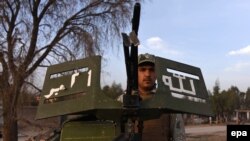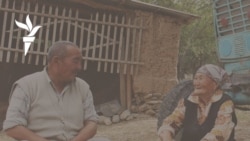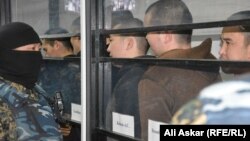
With the dreaded annual Taliban spring offensive expected to start in earnest any day now, there are many nervous people on both sides of the Central Asia-Afghan border.
The situation in northern Afghanistan is already more alarming and far more confusing than it was in the spring of 2016.
Adding to the anxiety, the Taliban recently published a map showing what they claim is territory in Afghanistan where they have influence, and while the Taliban is known to exaggerate its situation, some believe this map is fairly accurate and this site explains the color key.
To attempt to shed some light on the murky state of affairs along the Central Asia-Afghan border, RFE/RL assembled a Majlis, or panel, to discuss which groups are present in northern Afghanistan and the extent of their influence, or control in the region.
Moderating the discussion was RFE/RL Media Relations Manager Muhammad Tahir. From New Jersey, Bill Roggio, the editor of Long War Journal, who was earlier embedded with Canadian troops in Afghanistan, joined the Majlis. From Prague, we were happy to welcome back Amin Mudaqiq, the director of RFE/RL's Radio Mashaal, who has great knowledge of events in Afghanistan. And I've been following the situation in Afghanistan for a while so I jumped in with comments of my own.
First, the Taliban map that showed areas the group says it controls and areas that are contested to varying degrees.
Tahir broke that down, reminding us that there are more than 400 districts in Afghanistan and the Taliban claims to have 34 districts under its control, says 167 others are contested, and has a significant presence in 52 more districts.
Roggio said much of the map corresponds with what he has been seeing. "I think it was pretty accurate as far as the security situation in areas we could see… the reason I find it credible is not because it matches with the information that I currently have, but there are large areas of Afghanistan where they're saying, 'Look, we don't control any [of this] territory.'"
Mudaqiq agreed the Taliban has spread its influence across northern Afghanistan since spring 2016 but cautioned that "if control means to hold it [territory] as well, then the Taliban's claims are really exaggerated; but if control means the presence, yes, the Taliban have a presence in almost 50 percent of the country and even 60 percent in the east and south [of Afghanistan]."
And Mudaqiq said even with that estimate, "they [the Taliban] are there as long as there is no Afghan or coalition, ISAF, or NATO forces there."
IS Presence, At Least In Name
The Taliban is not the only militant group present in northern Afghanistan. Mudaqiq said one of the big reasons for the deterioration in the security situation in northern Afghanistan is "the increasing presence of Daesh [the Islamic State militant group]."
Mudaqiq recalled that earlier this year militants set fire to Sufi shrines in the Darzab district of Jowzjan Province, which borders Turkmenistan. "People in Darzab who were arrested by Daesh, and they [later] escaped, they claim that Daesh has a big presence there," he said.
And Roggio pointed out there are fighters from the Islamic Movement of Uzbekistan in northern Afghanistan, but on which side they are fighting is still unclear. "A large segment of the Islamic Movement of Uzbekistan swore allegiance to the Islamic State in 2015, so the group split and it's debatable how much joined the Islamic State and how much stayed loyal to Al-Qaeda and the Taliban," he said.
Mudaqiq noted that even among those claiming to be from IS there are divisions within Afghanistan, and that neither is like the IS groups in Syria and Iraq. "We have two kinds of Daesh, which are very different from each other. We have Daesh in [the eastern province of] Nangarhar, which is mostly made up of the Pakistani Taliban who lost control in their own area [of Pakistan]," he said. "On the other hand, you have Daesh or IS in northern Afghanistan who are only using the name of Daesh to survive."
Outside Actors
There is also the question of who outside of Afghanistan is helping whom. U.S. military commanders and Afghan officials have recently expressed concerns about Russia's connections to the Taliban, which may even include arming the militants, an accusation Russia denies.
Roggio said, "What I think is happening here is the Russians are reading the tea leaves in Afghanistan and they've determined that the U.S. and NATO is losing this war and that the Taliban are going to have a presence."
Roggio explained that if this is true, Russia is playing a dangerous game. "The Taliban are allied with numerous jihadist groups including Al-Qaeda, which has a far more significant presence when you put together Afghanistan and Pakistan as well as the satellite jihadist groups that are operating with the Taliban [and] these groups have been a threat to the Russians in the form of the Caucasus Emirate," he said.
An influential former Afghan mujahedin commander from the days of the Soviet occupation, Mohammad Ismail Khan, in early March accused Turkmenistan of aiding militants in northwestern Afghanistan, a charge Turkmen authorities quickly denied.
But Mudaqiq said, "Turkmenistan has a kind of history in dealing with extremist groups, in dealing with the Taliban, just to save and protect their own boundary," and he recalled that when the Taliban took over most of Afghanistan in the late 1990s the Turkmen Consulate in Herat Province, which borders Turkmenistan, continued to function.
Mudaqiq said that last year "some of the members of the National Assembly were complaining in Faryab [Province] and Jowzjan [Province] that some of the Taliban injured were also taken to Turkmenistan and they were treated there."
The situation is likely to become even more violent and confused in the coming months.
The Majlis discussed this and other issues, including comments from Mudaqiq about reports of militants "freely moving between Uzbekistan and Afghanistan through Tajikistan."
You can listen to the full discussion here:
Listen to or download the Majlis podcast above or subscribe to the Majlis on iTunes.








